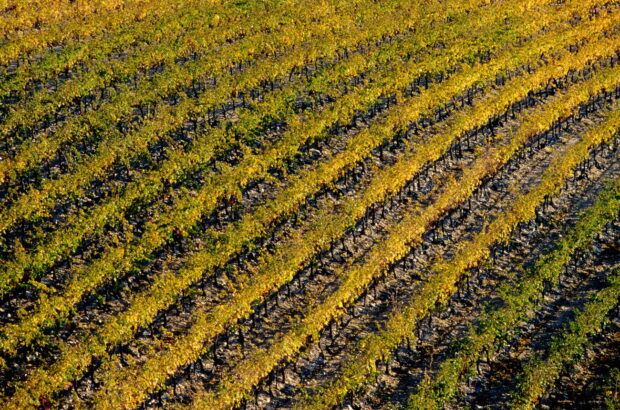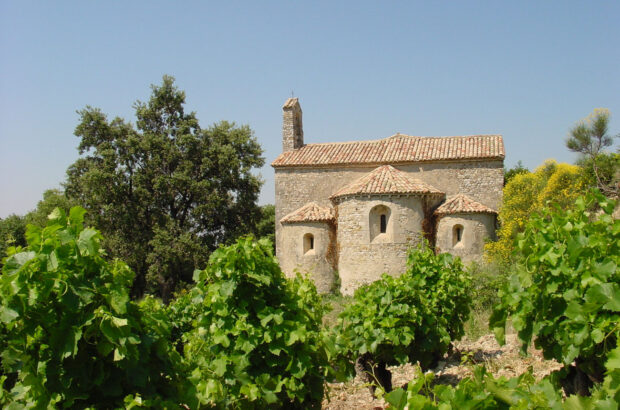Prime minister Jean Castex announced financial support amounting to ‘nearly €1bn’ as both he and agriculture minister Julien Denormandie visited French vineyards damaged by frost in the Hérault area of Languedoc.
Although damage was still being assessed, there were fears that between 30 and 50% of the potential Languedoc wine harvest may have succumbed to the sub-zero temperatures, said Languedoc wine body CIVL on 9 April.
Damage could be much worse in some cases and IGP vineyards in Hérault were among the worst-affected, CIVL said.
National wine union CNIV has said 80% of French wine regions were affected by the early April frosts, from Bordeaux and Burgundy to Rhône and the Loire.
French farming union FNSEA said this week that total agricultural losses from the spring frosts could total €3bn, ‘particularly in viticulture and arboriculture’.
Winemakers have cautioned that it is too soon to know the full extent of the damage, even if several regional bodies have said they expect the frosts to impact 2021 wine harvest volumes.
Frost has also hit vineyards and farmers in other parts of Europe this month.
In Italy this week, farmers’ union Coldiretti called for immediate government aid, including for vineyard owners that have seen damage from sub-zero temperatures.
The impact naturally varies between estates and vineyard sites.
Mas de Daumas Gassac, near Aniane in Languedoc, estimated this week that it would lose around 50% of its 2021 white wine harvest, despite several nights of 2am wake-up calls to light protective candles and fires in the vineyards.
‘It’s going to be tough but we’re going to make the best of it,’ said co-owner and winemaker Samuel Guibert, who also told Decanter that reds could be down in volume by 10% to 20% but that it was just too soon to be more precise.
Although Guibert has seen yields impacted by frost in 2017, mildew in 2018 and a heatwave in 2019, he said conditions this year were rare. ‘I’ve never seen trees frozen in April.’
Like others, he cautioned that frost would remain a risk for vineyards until well into May.
In Burgundy, Thiébault Huber, president of the Winegrowers of Bourgogne union (CAVB), said earlier this month, ‘All Bourgogne, from Chablis to Mâcon, has been affected [to some extent].’
He added, ‘We think that the Chardonnays, which are further ahead [in the growing cycle], will have been affected much more than the Pinot Noirs, which had not yet completed their bud break.’
Cécile Mathiaud, of Burgundy’s wine council (BIVB), said it was too early to make predictions about the 2021 harvest.
Plunging temperatures in early April also affected parts of Tuscany and Piedmont, although the impact appeared to be patchy and a full picture was again not yet clear.
In Tuscany, Renzo Cotarella, CEO of Marchesi Antinori, told Decanter on 13 April, ‘Last week’s frost has had repercussions on a few specific areas, not on extensive ones. So, many wine regions were affected starting with Montepulciano and Montalcino up to Vernaccia, as well as some flat areas of Maremma. While the areas that managed to get by a bit better at the moment are Chianti Classico and Bolgheri.’
He added, ‘However, it is really too soon to give any definitive opinion.’ It’s hard to know, for instance, whether buds that have not yet emerged will show signs of damage.
Tenuta di Trinoro winery, south of Montepulciano, was among those to escape relatively lightly so far – albeit thanks to extensive work by the vineyard team.
‘We’ve had another couple of cold nights until the candles were finished and it got warmer just in time, when we had run out of them,’ owner Andrea Franchetti told Decanter yesterday.
‘The team of 36 people were all so fantastic, and it took close to nine hours every night in a shivering cold to carry in, light up and then extinguish 3,500 candles. We came away with a few burns on maybe 300 plants of Merlot [where budding was more advanced],’ he said.
‘That vineyard alone has 90k plants. So, we were fortunate that we are situated in a late-growing place like Trinoro and that frost came in early on the calendar. We continue to monitor temperatures daily.’
Towards the coast, Ornellaia’s estate director, Axel Heinx, said, ‘As for most of Europe, the first week of April was characterised by a wave of cold temperatures, even in Bolgheri. The night of the 7 April temperatures went below 0°C in a number of vineyards of the area.
‘Most of Ornellaia’s vineyards lie on higher elevation and were almost entirely spared by frost, which occurred only in some specific spots, leaving most of our vineyards without damage.’
‘Disaster’ declared as frost hits French vineyards
Update as of 13 April 2021
France’s government has said it will declare an ‘agricultural disaster’ following severe spring frosts that look set to hit the country’s 2021 wine harvest and have also affected other parts of Europe – but winemakers stressed that they were still assessing the full impact on vineyards.
Frost and freezing temperatures impacted French vineyards to at least some extent in around 80% of the country’s wine regions, the CNIV wine union has said. ‘It is still too early to know precisely the extent of the damage, but 80% of regions have been affected’, said Jean-Marie Barillère, president of the CNIV.
It’s been described as one of the worst episodes of frost in decades, and there are reports that wine regions in other parts of Europe have also been affected to some extent.
Wine trade bodies in Bordeaux and the Rhône have already said that the 2021 harvest size will be affected.
However, winemakers stressed that they were still assessing potential damage. A mixed picture was emerging in some regions, too, depending upon grape variety and vineyard site.
French president Emmanuel Macron issued a message of support to French winemakers and farmers at the weekend. ‘Hold tight, we are by your side,’ Macron said.
Agriculture minister Julien Denormandie said he has launched the process of declaring an ‘agricultural disaster’. This enables financial support for winemakers and other farmers facing the loss of their 2021 crop.
The Inter Rhône trade body reported that the whole of the Rhône has been hit dramatically and that ‘some plots are affected 100%.’
‘We already know that some sectors have been affected in their entirety,’ said Philippe Pellaton, President of Inter-Rhône.
Bordeaux’s wine council, the CIVB, said frost affected all appellations in the region, with temperatures sometimes dropping below minus five degrees Celsius.
Damage was still being assessed, but the CIVB said late last week that it expected the frosts to hit production volumes in the Bordeaux 2021 vintage.
‘This frost episode has just wiped out a significant part of the work of the winegrowers, and of the harvest, in an already very trying period, both morally and economically,’ said the CIVB.
The best thing people can do to help is ‘buy wine’, it added.
However, it’s a mixed picture and frost impact will likely depend on several things, including the stage vines had reached in their growing cycle, and their location.
‘All Bourgogne, from Chablis to Mâcon, has been affected by this episode of extreme cold to varying degrees, depending on the state of the [vines’] vegetative cycle,’ said Thiébault Huber, president of the Winegrowers of Bourgogne union (CAVB), last week.
‘We think that the Chardonnays, which are further ahead [in the growing cycle], will have been affected much more than the Pinot Noirs, which had not yet completed their bud break,’ he told Decanter. A full assessment would not be possible for a few weeks.
There has been some discussion about whether wine prices could be affected, but merchants feel it’s too soon to know the market impact.
Will Hargrove, associate director and head of fine wine at UK merchant Corney & Barrow, said, ‘It is always concerning when there is frost like this and it does seem to have been more severe than more recent years. It is very much at the stage where they are assessing the damage.’
Impact in Piedmont
In Piedmont, it also appeared to be a mixed picture. While there’s been an impact, there was also a degree of relief among some producers on Tuesday (13 April).
‘Our crus, Ravera in Novello, Cannubi in Barolo and Lazzarito in Serralunga d’Alba, were spared from the drop in temperature that occurred during the night between 7 and 8 April, thanks to favorable exposure,’ said Daniele Gaia, of Reva winery.
‘We have encountered some problems in the lower rows in Monforte where, fortunately, there are no Nebbiolo grapes destined for Barolo wine.’
Giovanni Minetti, CEO of Tenuta Carretta, said of the black frost that affected Roero and the Langhe last week, ‘Although another three or four weeks will be needed to have a more precise assessment on the buds, at the moment it seems that the late budding varieties (such as Arneis and Barbera) have not suffered any damage.’
‘As for Nebbiolo, the earliest of the varieties, the situation is not the same everywhere: some plants show damage that affected some buds while leaving the others intact.
‘The most affected vineyards (damaging around 30% of the buds) are those with an intermediate location, while temperature inversion has spared the vineyards located in higher and lower positions, currently showing minimal damage estimated at around 5-10%.’
He said the situation was different from the 2017 frosts, which occurred around two weeks later in April. ‘However, this unstable period is far from over,’ he added.
UK on alert
In the UK, Mardi Roberts at Ridgeview told Decanter that the vineyards were around two weeks behind the growth cycle in mainland Europe but the team had been lighting candles in vulnerable Chardonnay vineyards over the past two nights this week.
‘Last night was particularly severe with around -3 [degrees Celsius] in the vineyard close to sunrise,’ Roberts said. ‘Our vineyard manager of 18 years, Matt Strugnell, remarked that it was one of the worst frosts he can remember but we are hoping with the size of the buds and the great work in lighting the bougies [candles] that we will have minimal damage. The next couple of days remain touch and go.’
Thursday 8th April
There were growing fears that frost may have caused significant damage to French vineyards in several regions this week.
Many winemakers have lit candles and controlled fires next to rows of vines in order to help protect the emerging 2021 crop from a sudden drop in temperatures. Aerial photos on social media showed hundreds of candles lit across vineyards.
Some producers also launched helicopters to fly above their vineyards, a method that can help to prevent frost by encouraging warm air to circulate.
There were particular concerns on Thursday (8 April) about vineyards in Bordeaux and Burgundy, although winemakers cautioned that the full picture was still unclear.
Bordeaux’s regional wine council, the CIVB, said damage was still being assessed but that ‘it is already certain that this spring frost will severely impact the volume of the 2021 harvest’.

Fires lit to prevent frost damage on Domaine Belleville’s vines in ‘les Cloux’ premier cru in Rully. Photo Credit: Domaine Belleville.
In Burgundy, Jean-Luc Vitoux, of Domaine Belleville in Rully, told Decanter, ‘The last three nights, with temperatures between -3°/-6° [Celsius] and the snow on the night of the 6/7 April, very seriously damaged the vineyards of Chardonnay at Domaine Belleville, even if candles burned during these nights to try to protect them.’
Vitoux, who is also director at the sister estate, Domaine de la Commaraine, said the estate’s Pinot Noir vineyards of Clos de la Commaraine in Pommard and also in Côte de Nuits appeared to be less damaged.
‘All Bourgogne, from Chablis to Mâcon, has been affected by this episode of extreme cold to varying degrees, depending on the state of the [vines’] vegetative cycle,’ said Thiébault Huber, president of the Winegrowers of Bourgogne union (CAVB).
‘We think that the Chardonnays, which are further ahead [in the growing cycle], will have been affected much more than the Pinot Noirs, which had not yet completed their bud break,’ he told Decanter.
‘It is currently impossible to assess the actual damages. They will really show in a few weeks.
‘Bourgogne winegrowers did what they could to fight, but each period of frost was too long and the temperatures were too low. Nature has been stronger than us.’
He added, ‘From now on, we hope that this episode will be the last and that the secondary buds will be strong enough.’
He said producers would remain vigilant, particularly as temperatures are expected to drop again next week.

Winemakers have been keeping a close on vineyards. This photo shows anti-frost efforts at Château Lapourcaud in the Bordeaux area. Photo credit: Vincent Gas.
In Champagne, temperatures fell to minus seven degrees Celsius for two nights this week, according to the local chamber of agriculture for the Marne area.
It said on Twitter that Champagne vines had ‘not been spared’ from frost but the impact varied. It reported some damage to early budding Chardonnay, but also ‘little to no impact’ on later varieties, Pinot Noir and Pinot Meunier, so far.
In a follow-up tweet, it added, ‘To date, it is difficult to quantify the damage because this episode of freezing is not over and the symptoms will only be visible within a few days. To be continued…’
In Bordeaux, many winemakers also lit fires and did what they could to limit the impact of the sub-zero temperatures.

Fires were lit in Bordeaux vineyards to help fight against frost and sub-zero temperatures. This shows one fire at Château Lapourcaud. Photo credit: Vincent Gas.
News station France 3 reported damage to vineyards in the Graves area, but again the full extent of any impact was not yet known.
As reported above, Bordeaux wine council, the CIVB, said the impact of frost was severe across large parts of the region’s vineyards – but it cautioned that damage was still being assessed.
‘The entire industry wishes to express its solidarity with all these women and men who found themselves powerless in the face of this exceptional frost,’ said CIVB president Bernard Farges.
Chateau de L’Hospital, in Graves, said on Facebook that, despite its efforts in the face of temperatures ranging from minus three to minus six Celsius, ‘the vines did not resist, notably in our Merlot parcels’. But the estate added full damage wasn’t yet clear. ‘We are not giving up.’
On the other side of the country, France Bleu reported significant damage to some vineyards in the Arbois appellation in Jura, too.
Updated at 3:50pm on Thursday 8th April with comments from the CIVB in Bordeaux. Additional reporting by Ellie Douglas.







